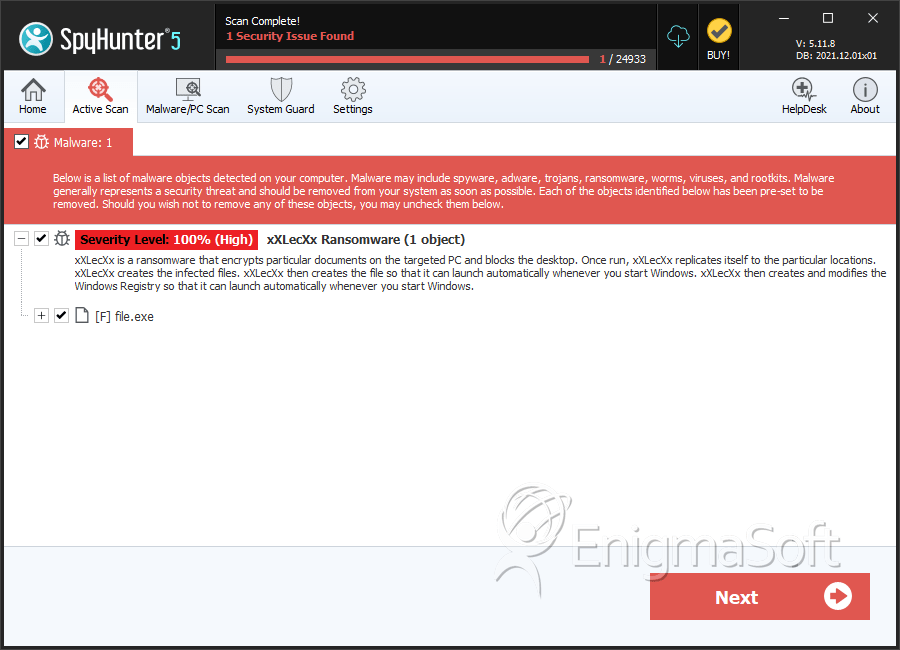xXLecXx Ransomware
The xXLecXx Ransomware is a lock screen ransomware Trojan. What this means is that the xXLecXx Ransomware is designed to take the victim's computer hostage by displaying a lock screen, which is a full-screen message that prevents the victim from using the affected computer. Lock screen Trojans were an especially popular threat variant several years ago, with various tactics associated with them. For example, one variety of lock screen ransomware Trojans would impersonate the law enforcement, tricking the victim into thinking that the police have locked their computers, in an attempt to extract a 'fine.' These ransomware Trojans have been replaced by encryption ransomware Trojans largely, which instead take the victim's data hostage by encrypting it with a strong encryption algorithm. This is a more effective attack because, even if the ransomware Trojan is removed, the victim's data remains encrypted. However, PC security researchers see a resurgence of the lock screen tactic. Now, however, lock screen Trojans like the xXLecXx Ransomware are disguising themselves as encryption ransomware, claiming to the victims that their files were encrypted and displaying the 'ransom note' in a lock screen. Fortunately, these Trojans are not capable of encrypting the victim's data and can be removed with relative ease, compared to encryption ransomware Trojans.
Table of Contents
Fortunately the xXLecXx Ransomware can’t Encrypt Your Files
Despite its claims, the xXLecXx Ransomware is not designed to encrypt the victims' files. Rather, the xXLecXx Ransomware claims that it does it in an effort to trick inexperienced computer users into paying a large ransom amount. The xXLecXx Ransomware is very similar to several other ransomware Trojans using a similar tactic that has been in use since May 2017. The xXLecXx Ransomware displays a lock screen on the victim's computer, with a ransom note that is typical of an encryption ransomware message (claiming that the victim's files were encrypted and demanding the payment of a ransom. The xXLecXx Ransomware ransom note claims that the victim must pay $150 USD in BitCoins to an xXLecXx Ransomware attack. The xXLecXx Ransomware is not capable of encrypting the victims' files, and these claims should be ignored. The following is the 'ransom note' used by the xXLecXx Ransomware in its program window lock screen:
'Your files are encrypted with the xXLecXx Ransomware
Your files have been encrypted by the xXLecXx Ransomware.
You cannot access your PC right now. You have 2 options
1. We delete all your files
2. You pay us $150 USD and we decrypt all your files
The choice is yours. If you choose option 2, click the button below, (What to Do) and pay us $150 USD and get a decrypt code
What to Do
Have your decrypt code? Submit it here. [TEXT BOX] Submit'
Dealing with and Preventing the xXLecXx Ransomware Infections
The most likely source of an xXLecXx Ransomware infection is through corrupted spam email messages. The xXLecXx Ransomware will appear on the infected computer's Task Manager, listed as xXLecXx.exe. However, the xXLecXx Ransomware will block access to the Task Manager, Registry Editor, and other utilities that could be used to stop the xXLecXx Ransomware lock screen. However, PC security researchers have observed that some variants of the xXLecXx Ransomware can be bypassed through the use of keyboard shortcuts. If no standard methods are allowing you to bypass the xXLecXx Ransomware message, it is usually effective to start up Windows using Safe Mode or using an alternate start up drive. Once access has been restored to the infected computer, the xXLecXx Ransomware infection itself can be erased with the help of a reliable security program. To prevent further xXLecXx Ransomware infections, it is important to pay attention when browsing the Web and avoid any suspicious email attachments and unsolicited downloads, even if they appear to come from a trusted source superficially.
SpyHunter Detects & Remove xXLecXx Ransomware

File System Details
| # | File Name | MD5 |
Detections
Detections: The number of confirmed and suspected cases of a particular threat detected on
infected computers as reported by SpyHunter.
|
|---|---|---|---|
| 1. | file.exe | 7381f2d9c160a1a006f63c2cdc8f4860 | 0 |

